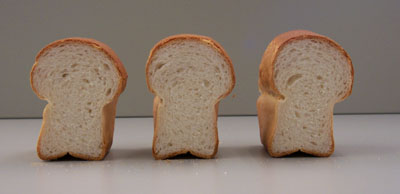
Baking 100 g flour loaves is applicable to determine effect of environment, variety, and wheat flour components. This procedure provides an optimized bread-making method for evaluating bread wheat flour quality. All ingredients are incorporated in the initial mixing step. The method is a 90 min, sugar-based, fermented dough system. The bread formula contains 100 g flour, 6 g sugar, 3.5 g shortening, 1.8 g yeast, 1.5 g salt, 180 ppm Doh-Tone (fungal alpha-amylase), and 150 ppm ascorbic acid as an oxidant. In the test, mixing time, oxidation level, fermentation time, and water absorption are optimized and balanced. AACC Method 10-10B.
9.1. Mixing Time
The time required in minutes for dough to reach point of minimum mobility. The test baker determines optimum mixing time. The appearance of the dough changes during mixing. The lumpy mass obtained after initial wetting is transformed into a coherent mass that exhibits elasticity. When optimum development is reached, the dough has elastic properties and appears smooth across the pins. If mixing is continued beyond the peak of development (over mixed), the dough becomes very sticky, extensible, and appears shiny.
9.2. Water Absorption
The amount of water required to make a dough of proper consistency for bread baking when mixed to optimum conditions based on the feel and appearance of the dough as judged by an experienced baker.
9.3. Loaf Volume
The volume of a loaf of bread is determined by canola seed displacement. Loaf volume is a good measurement of protein quality.
9.4. Crumb Grain Score
Subjective judgement of crumb grain quality is determined by an experienced baker. The bread is allowed to cool on racks 2 hours before the appearance of the loaf is noted and the crumb grain graded. The general appearance and inside cellular structure is what determines a quality crumb grain.